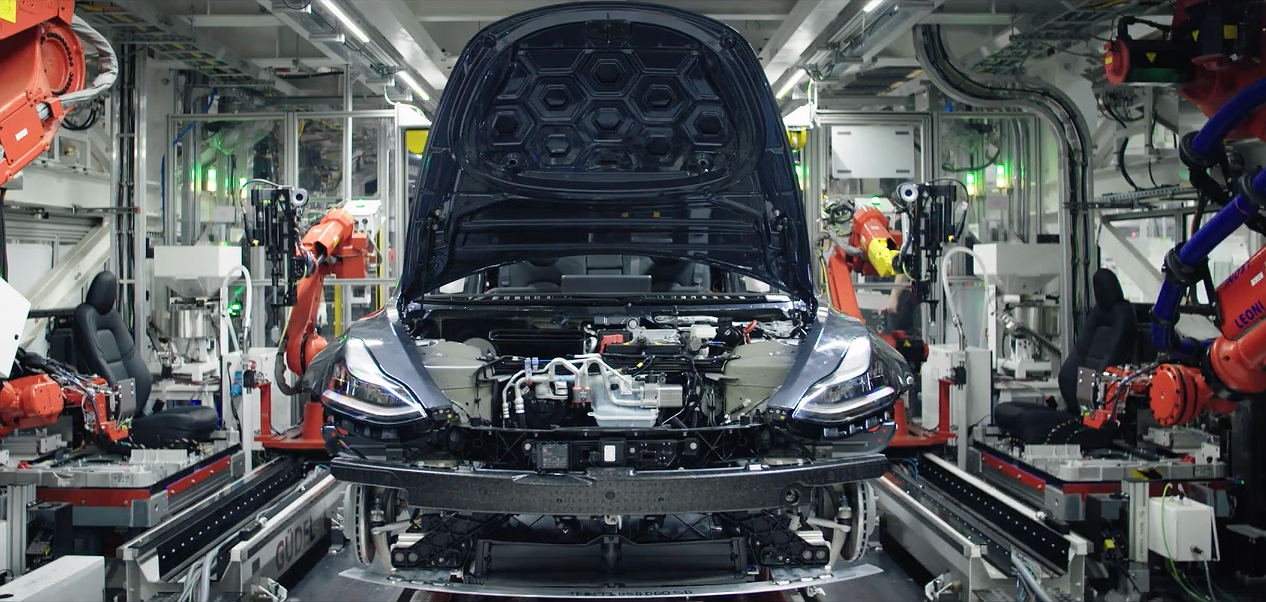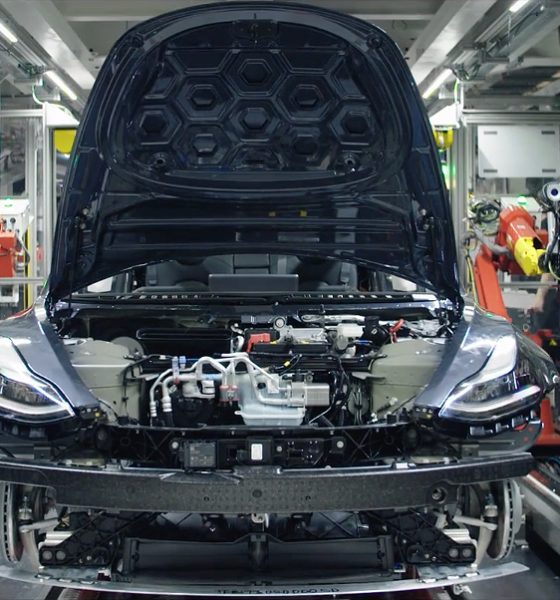

Investor's Corner
Tesla to sustain Model 3 “burst” production rate in July, suggests online tracker
Tesla’s capability to sustain its rate of manufacturing 5,000 Model 3 per week this third quarter remains in question, but an online tracker by Bloomberg suggests that the Silicon Valley electric car maker is on pace to hit peak production levels in the next few weeks.
Tesla was finally able to manufacture 5,000 Model 3 per week during the final seven days of the second quarter, thanks to a blitz of activity in the Fremont factory. Tesla had to implement a number of unorthodox strategies to achieve the production milestone, including building an entirely new general assembly line inside a massive sprung structure at the grounds of the Fremont factory and air-freighting six airplanes’ worth of robots from Europe. These, together with Tesla’s “burst” build, were considered by critics to be unsustainable.
Doubts about Tesla’s capability to maintain its 5,000/week Model 3 production rate fueled the thesis of the company’s most vocal critics, such as JP Morgan analyst Ryan Brinkman, who wrote that Tesla’s burst production could not be repeated. CFRA Research analyst Efraim Levy also downgraded TSLA to a Sell, stating that the burst rate for Model 3 production is the not “operationally or financially sustainable.” These reservations affected Tesla’s stock (NASDAQ:TSLA), with the company ending the week at $308.88 per share, a significant drop from the near-record highs it achieved earlier in June.
Bloomberg’s Tesla Model 3 tracker as of 7/9/18. [Credit: Bloomberg]
If the current numbers reflected in Bloomberg‘s Model 3 online tracker are any indication, however, it appears that Tesla might just be on track to produce the Model 3 at a sustained rate of the 5,000 vehicles per week. As of this weekend, the online tracker, which was just 2% off its prediction for Tesla’s final Q2 numbers, shows a trend of more than 5,000 Model 3 per week over the next three weeks. Apart from this, production of the compact electric car is also listed at 5,187 Model 3 per week.
Bloomberg‘s Tesla Model 3 production tracker aggregates data from U.S. government resources, social media reports, as well as direct communication with Tesla owners. VINs that are listed in the tracker are either traced depending on Tesla’s own filings during batch registrations, or sightings of Model 3 in the wild. Vehicle Identification Numbers do not directly correspond to the number of Model 3 that Tesla is producing, but Elon Musk himself admitted in the Q1 2018 earnings call that “any information that (Tesla) provide(s) would be one week or two in advance of what will become public knowledge just due to vehicle registrations and shipments that are tracked very carefully.”
Tesla is now attempting to hit sustained profitability for the first time in its history. During Q2 2018, Elon Musk boldly declared on Twitter that Tesla would start being profitable around Q3 or Q4 2018. During the first quarter earnings call, Musk reiterated this, stating that it was about time Tesla starts showing some earnings. In order to accomplish this goal, Tesla would have to ensure that the Model 3 gets built and delivered at a pace that is sustainable.
Considering the sales numbers of the Model 3, it appears that if Tesla can keep its production rate steady, it would only be a matter of time before the vehicle can help push the company towards profitability. In Tesla’s Q2 2018 Production and Delivery report, the company stated that it had delivered 18,440 Model 3 from April-June 2018. Tesla also had 11,166 Model 3 vehicles in transit to customers by the time the quarter ended, setting up the third quarter for record deliveries and sales. The Chevy Bolt EV, considered as the Model 3’s main rival, had sales of 3,483 vehicles during Q2 2018, 82% less than the Model 3.

Investor's Corner
Tesla stock closes at all-time high on heels of Robotaxi progress

Tesla stock (NASDAQ: TSLA) closed at an all-time high on Tuesday, jumping over 3 percent during the day and finishing at $489.88.
The price beats the previous record close, which was $479.86.
Shares have had a crazy year, dipping more than 40 percent from the start of the year. The stock then started to recover once again around late April, when its price started to climb back up from the low $200 level.
This week, Tesla started to climb toward its highest levels ever, as it was revealed on Sunday that the company was testing driverless Robotaxis in Austin. The spike in value pushed the company’s valuation to $1.63 trillion.
Tesla Robotaxi goes driverless as Musk confirms Safety Monitor removal testing
It is the seventh-most valuable company on the market currently, trailing Nvidia, Apple, Alphabet (Google), Microsoft, Amazon, and Meta.
Shares closed up $14.57 today, up over 3 percent.
The stock has gone through a lot this year, as previously mentioned. Shares tumbled in Q1 due to CEO Elon Musk’s involvement with the Department of Government Efficiency (DOGE), which pulled his attention away from his companies and left a major overhang on their valuations.
However, things started to rebound halfway through the year, and as the government started to phase out the $7,500 tax credit, demand spiked as consumers tried to take advantage of it.
Q3 deliveries were the highest in company history, and Tesla responded to the loss of the tax credit with the launch of the Model 3 and Model Y Standard.
Additionally, analysts have announced high expectations this week for the company on Wall Street as Robotaxi continues to be the focus. With autonomy within Tesla’s sights, things are moving in the direction of Robotaxi being a major catalyst for growth on the Street in the coming year.
Elon Musk
Tesla needs to come through on this one Robotaxi metric, analyst says
“We think the key focus from here will be how fast Tesla can scale driverless operations (including if Tesla’s approach to software/hardware allows it to scale significantly faster than competitors, as the company has argued), and on profitability.”

Tesla needs to come through on this one Robotaxi metric, Mark Delaney of Goldman Sachs says.
Tesla is in the process of rolling out its Robotaxi platform to areas outside of Austin and the California Bay Area. It has plans to launch in five additional cities, including Houston, Dallas, Miami, Las Vegas, and Phoenix.
However, the company’s expansion is not what the focus needs to be, according to Delaney. It’s the speed of deployment.
The analyst said:
“We think the key focus from here will be how fast Tesla can scale driverless operations (including if Tesla’s approach to software/hardware allows it to scale significantly faster than competitors, as the company has argued), and on profitability.”
Profitability will come as the Robotaxi fleet expands. Making that money will be dependent on when Tesla can initiate rides in more areas, giving more customers access to the program.
There are some additional things that the company needs to make happen ahead of the major Robotaxi expansion, one of those things is launching driverless rides in Austin, the first city in which it launched the program.
This week, Tesla started testing driverless Robotaxi rides in Austin, as two different Model Y units were spotted with no occupants, a huge step in the company’s plans for the ride-sharing platform.
Tesla Robotaxi goes driverless as Musk confirms Safety Monitor removal testing
CEO Elon Musk has been hoping to remove Safety Monitors from Robotaxis in Austin for several months, first mentioning the plan to have them out by the end of 2025 in September. He confirmed on Sunday that Tesla had officially removed vehicle occupants and started testing truly unsupervised rides.
Although Safety Monitors in Austin have been sitting in the passenger’s seat, they have still had the ability to override things in case of an emergency. After all, the ultimate goal was safety and avoiding any accidents or injuries.
Goldman Sachs reiterated its ‘Neutral’ rating and its $400 price target. Delaney said, “Tesla is making progress with its autonomous technology,” and recent developments make it evident that this is true.
Investor's Corner
Tesla gets bold Robotaxi prediction from Wall Street firm
Last week, Andrew Percoco took over Tesla analysis for Morgan Stanley from Adam Jonas, who covered the stock for years. Percoco seems to be less optimistic and bullish on Tesla shares, while still being fair and balanced in his analysis.

Tesla (NASDAQ: TSLA) received a bold Robotaxi prediction from Morgan Stanley, which anticipates a dramatic increase in the size of the company’s autonomous ride-hailing suite in the coming years.
Last week, Andrew Percoco took over Tesla analysis for Morgan Stanley from Adam Jonas, who covered the stock for years. Percoco seems to be less optimistic and bullish on Tesla shares, while still being fair and balanced in his analysis.
Percoco dug into the Robotaxi fleet and its expansion in the coming years in his latest note, released on Tuesday. The firm expects Tesla to increase the Robotaxi fleet size to 1,000 vehicles in 2026. However, that’s small-scale compared to what they expect from Tesla in a decade.
Tesla expands Robotaxi app access once again, this time on a global scale
By 2035, Morgan Stanley believes there will be one million Robotaxis on the road across multiple cities, a major jump and a considerable fleet size. We assume this means the fleet of vehicles Tesla will operate internally, and not including passenger-owned vehicles that could be added through software updates.
He also listed three specific catalysts that investors should pay attention to, as these will represent the company being on track to achieve its Robotaxi dreams:
- Opening Robotaxi to the public without a Safety Monitor. Timing is unclear, but it appears that Tesla is getting closer by the day.
- Improvement in safety metrics without the Safety Monitor. Tesla’s ability to improve its safety metrics as it scales miles driven without the Safety Monitor is imperative as it looks to scale in new states and cities in 2026.
- Cybercab start of production, targeted for April 2026. Tesla’s Cybercab is a purpose-built vehicle (no steering wheel or pedals, only two seats) that is expected to be produced through its state-of-the-art unboxed manufacturing process, offering further cost reductions and thus accelerating adoption over time.
Robotaxi stands to be one of Tesla’s most significant revenue contributors, especially as the company plans to continue expanding its ride-hailing service across the world in the coming years.
Its current deployment strategy is controlled and conservative to avoid any drastic and potentially program-ruining incidents.
So far, the program, which is active in Austin and the California Bay Area, has been widely successful.








